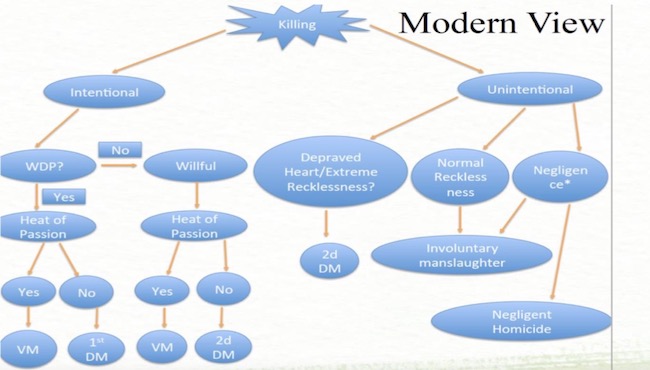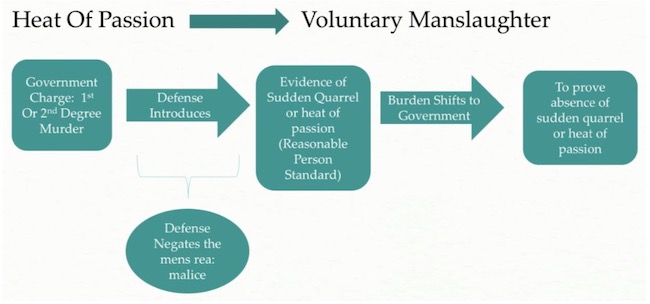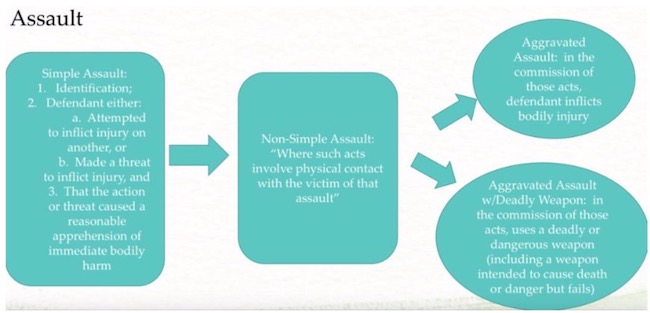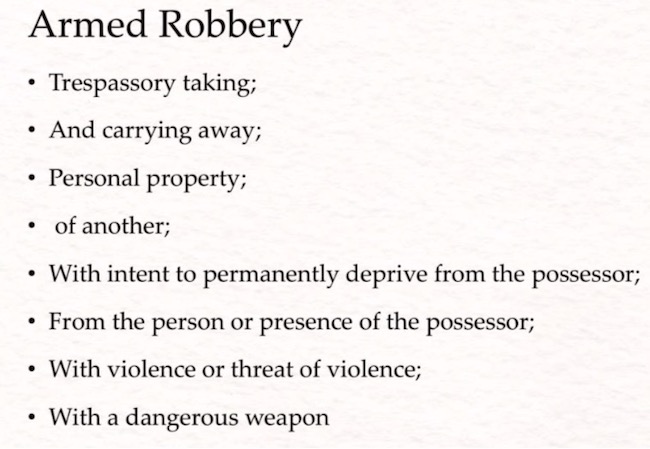Criminal Law Outline - Professor Ghiotto - Campbell Law - Part 2
By Miller Moreau
Professor Ghiotto - 2019
Download the PDF version of this outline
Crimes Causing Death- Harshest penalties are assigned to those crimes in which the death of a person is caused by the defendant’s actions
- We order homicides according to what the defendant was THINKING rather than what she was DOING
- Four Categories of Crimes Involving Death:
- First Degree Murder
- Second Degree Murder
- Voluntary Manslaughter
- Involuntary Manslaughter
- Additional Crimes:
- Capital murder
- Third Degree Murder
- Negligent Homicide
- Elements in Common:
- Identification of actual killer
- Actual death of a victim
- Causation of the death
- Categories differentiated by state of mind elements and elements relating to the circumstances surrounding the killing
 Second Degree Murder
Second Degree Murder - 1) Within the special maritime and territorial jurisdiction of the United States; 2) Identification of the killer; 3) Actual death; 4) Causation of the death by the defendant; 5) Unlawfulness; and 6) Malice aforethought.
- Unlawfulness means that the killing was not justified under the law
- Malice aforethought can be established by evidence of conduct which is “reckless and wanton, and a gross deviation from a reasonable standard of care, of such nature that a jury is warranted in inferring that defendant was aware of a serious risk of death or serious bodily harm. (U.S. v. Milton)
- Jury can convict a defendant of second-degree murder under an “extreme disregard” theory even if the acts causing the victim’s death were reckless only toward the victim herself. (U.S. v. Houser)
- 1) Within the special maritime and territorial jurisdiction of the United States; 2) Identification of the killer; 3) Actual death; 4) Causation of the death by the defendant; 5) Unlawfulness; and 6) Malice aforethought (Deliberate and Intentional); 7) At least one of the following must be proven:
- Premeditation (requires premeditation)
- That the death was caused in the course of committing *arson, escape, murder, kidnapping, treason, espionage, sabotage, sexual abuse, burglary or robbery (ALL ENUMERATED FELONIES-Felony Murder).
- Perpetrated as part of an assault or torture against at least one child, OR
- That the death was caused during a premeditated attempt to kill someone other than the actual victim. (requires premeditation)
*Proof of premeditation is often circumstantial
*Enumerated felony
- That the death was caused in the course of committing arson, escape, murder, kidnapping, treason, espionage, sabotage, sexual abuse, burglary or robbery. Or as part of an assault or torture against at least one child.
- Charged as first-degree murder
- Intent, recklessness, or negligence don’t need to be shown
- Other issues such as proximate cause can be important
- Enumerated felony
- Intent to commit underlying felony and not intent to kill
- Allows defendant to be found guilty of 1st or 2nd Degree Murder
- Enumerated usually leads to 1st Degree Murder
- Inherently dangerous leads to 2nd Degree Murder
- (Smoking crack is inherently dangerous)
- Government will argue “death was in furtherance of the felony”
- The act needs to be in furtherance of the felony
- In furtherance of and the proximate cause
- (Ex. Paul’s presence in the apartment, the act which caused Pete’s death, was in furtherance of the felony. But, to prove proximate cause, the government must establish that Pete’s death was a foreseeable result of Paul entering into the apartment. Absent additional facts, it was not foreseeable that Pete would have had a heart attack.)
- Manslaughter is a category of crime resulting in death that is less severely punished than murder.
- Two distinct crimes:
- Voluntary Manslaughter
- Involuntary Manslaughter
- Manslaughter is distinct from murder because it is a killing “without malice.”
- Manslaughter is the unlawful killing of a human being without malice. It is of two kinds:
- Voluntary: Upon sudden quarrel or heat of passion
- Involuntary: In the commission of an unlawful act not amounting to a felony, or in the commission in an unlawful manner, or without due caution and circumspection, or a lawful act which might produce death.
- Within the special maritime and territorial jurisdiction of the United States.
- Manslaughter is the unlawful killing of a human being without malice. It is of two kinds:
- Elements:
- Committed within the maritime or territorial jurisdiction of the United States,
- Identification of the killer,
- Actual death,
- Causation of the death (upon a sudden quarrel or heat of passion), and
- Unlawfulness
- “Upon a sudden quarrel or heat of passion” is a fact that defense will often raise in order to reduce the charge from murder. (ex. could be 2nd degree murder, but Defendant raised this defense, so the burden shifts to prosecutor to prove it wasn’t sudden quarrel or heat of passion)
*Defense will try and mitigate 1st or 2nd Degree Murder down to voluntary
…
- Sudden quarrel or heat of passion are simply not essential elements of voluntary manslaughter, and therefore, they need not be proven by evidence beyond a reasonable doubt.
- The defendant attempts to negate the malice element by claiming, in essence, that she was not acting maliciously because some extreme provocation, beyond what a reasonable person could be expected to withstand, severely impaired their capacity for self-control in committing the killing.
- Once the issue is introduced, burden shifts to government to prove beyond a reasonable doubt the ABSENCE of sudden quarrel or heat of passion.
- It is NOT the burden of the government to also prove the presence of sudden quarrel or heat of passion before a conviction for voluntary manslaughter can stand in a murder trial
- Manslaughter is the unlawful killing of a human being without malice.
- Involuntary Manslaughter: In the commission of an unlawful act not amounting to a felony, or in the commission in an unlawful manner, or without due caution and circumspection, of a lawful act which might product death.
- Elements:
- Committed within the maritime or territorial jurisdiction of the United States,
- Identification of the killer,
- Actual death,
- Causation of the death,
- Unlawfulness, and
- At least one of the following:
- The killing occurred during the commission of a misdemeanor.
- The killing occurred during the commission of a lawful act without due caution or circumspection. (Most common and some level of negligence must be proven)
- The killing occurred during the commission of a lawful act in an unlawful manner.
 Robbery
Robbery - Identification of the defendant,
- The use of force or threat of force,
- To take the property of another from the person or presence of the victim
- With the intent of depriving the victim of that property.
Bank robberies are often taken as federal crimes, though they are also illegal under state laws
When there is no physical force or threat emphasized or cleanly shown, the violent crime of robbery may look similar to non-violent crimes including burglary and extortion.
Assault- Federal system has different culpability levels for assault ranging from simple assault (can be a misdemeanor) to aggravated assault that involves weapons and/or injury.
- Simple Assault-Does not require physical contact, but just the threat of injury
- Assault statutes cover “battery”
- The crime of harmfully using physical force against another person.
- Modern assault statutes incorporate both physical contact based battery and causing the fear of such physical contact
- Many jurisdictions no longer refer to “battery” in their criminal codes
- “Simple Assault”-Either a willful attempt to inflict injury upon the person of another, or by a threat to inflict injury upon the person of another which, when couple with an apparent present ability, causes a reasonable apprehension of immediate bodily harm.”
- Identification of the defendant as the actor,
- That the defendant either:
- Attempted to inflict injury on another, or
- Made a threat to inflict injury, and
- That the action or threat caused a reasonable apprehension of immediate bodily harm.

Simple Assault=No Contact
 Property Crimes
Property Crimes - Larceny
- Burglary
- Embezzlement
- Fraud
- Extortion
- Money Laundering
- Taking someone else’s property without their consent
- Elements:
- Identification of the offender;
- The taking of a thing of value (general intent);
- Without the consent of the owner; and
- With the intent to deprive the owner of the value of that thing (specific intent)*
* Some criminal codes will omit the fourth element
- Mistake of Fact Defense=Negating the specific intent element; would have to prove the subjective standard
- Typically end up in state court
- Unless, it is a taking of a post office, federally insured bank, theft of computer data, and even a person’s identity
- Knowledge that a vehicle is stolen can be established via evidence. (Uder)
- Taking? Common law states the “carrying away”
- To constitute a “carrying away” the property need not be actually removed from the place or premises where it was kept. Asportation of the property with the intention to appropriate it is sufficient to constitute larceny even though the property may subsequently be returned to the owner
- “Taking” in common law is the trespassory (wrongful) taking and carrying away
- Usually a crime involving property but doesn’t have to be
- Requires proof that the defendant illegally entered a building with the intent to commit a crime
- In some places, intent can be formed after the illegal entry
- Intent to commit the felony therein
- Does not require completion of the underlying crime-just that the person enter (or, under some statutes, unlawfully remain within) a building with the intent to commit a crime. Under some laws, it is not necessary to show that the entry itself be illegal.
- (Ex. The federal law covering both robbery and burglary of a bank does not require that the entry be illegal, so long as the intent to commit a crime exists at the time of the entry.
- Entry of a building
- Entry into a dwelling at night
- Higher form of larceny; gets more punishment
- Common Law:
- Breaking and entering (general intent)
- Breaking a window and unlocking the door
- Entering without permission
- Of a dwelling of another,
- In the nighttime,
- With intent to commit felony therein (specific intent) (e.g. murder, rape, aggravated assault, etc.)
- Any felony
- Larceny, rape, etc. would be underlying felony
- Breaking into neighbors home, who are out of town to smoke crack.
- Breaking into the home to smoke crack would be burglary
- Breaking and entering (general intent)
- Normally requires that the defendant converted his or her own use of property that was entrusted to them
- Converted to personal use
- Taking someone’s property through false pretenses
- It is common for the victim to consent to the taking of property; the key is that they granted this consent because of misrepresentation by the defendant
- Distinctive element in fraud cases is deception
- Some jurisdictions call this “larceny by trick” and “larceny by false pretenses”
- Intention use of wrongful deception for personal gain
- Good faith can serve as a defense to fraud charges. If a defendant truly believed what they were saying to be true-even if it was in fact misleading-this sometimes will be seen as something other than a fraudulent statement, and the proofs going to that element will fail
- “Defraud” or the wronging one of his property rights by dishonest methods or schemes
- The intent requirement targets a “willful act by the defendant with the specific intent to deceive or cheat, usually for the purpose of getting financial gain for one’s self or causing financial loss to another.”
- Elements:
- There was a scheme to defraud;
- Wires were used in furtherance of the scheme; and
- Defendant participated in the scheme with the intent to defraud. (specific intent)
- Intent to defraud may be established by circumstantial evidence and by inferences drawn from examining the scheme itself that demonstrate that the scheme was reasonably calculated to deceive persons of ordinary prudence and comprehension.
- Fraudulent intent may be proven by showing that the defendant made misrepresentations with knowledge that the statements were false.
- Modern federal criminal law protects things like trade secrets and personal property, which can have financial value just as physical property might
- Customer lists may be a trade secret where “it is the end result of a long process of culling the relevant information from lengthy and diverse sources, even if the original sources are publicly available.
- Person’s identity can be stolen for access to money, the privileges of citizenship, and other things of value
- The government must prove that the defendant knew that he or she was stealing an actual person’s identity
- Elements:
- The defendant knowingly transferred or used a means of identification of another person without legal authority.
- The defendant knew the means of identification belonged to a real person; and
- The defendant did so in relation to one of the crimes enumerated in…
Evidence of a defendant’s repeated submission of false identifying information as part of successful applications to a government agency is sufficient to permit a reasonable jury to find that the defendant knew that the information belonged to a real person. (Doe)
Helpful Information About Criminal Charges- Criminal Defense
- DUI/DWI
- Drug Crimes
- Larceny, Embezzlement & Fraud
- Domestic Violence, Assault & Battery
- Chapter 15 - Criminal Procedure
- Super Lawyers
The Charlotte lawyers at Powers Law Firm PA are dedicated to compassionate legal representation, predicated on superlative knowledge, trial skills, and conscientious advocacy.
The gift of a legal education extends beyond a fulfilling way to earn a living. Omni autem cui multum datum.
 Powers Law Firm PA Home
Powers Law Firm PA Home













